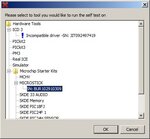maark6000
Member level 5

- Joined
- Jan 15, 2013
- Messages
- 92
- Helped
- 1
- Reputation
- 2
- Reaction score
- 1
- Trophy points
- 1,288
- Activity points
- 2,270
August 2014... time to update this.
So I'm learning to code the Microchip PIC chips... and I'm at the point where I want to buy a programmer. I'm using MPLAB X on a MacBook Pro. Which Programmer do I get?
I see all kinds of horror stories about the PicKit 3... issues with not enough USB power to program the chips, also issues with having to use a separate header board to target somethingerother...
Also many complaints from PicKit 2 owners... seems like it's no longer supported in MPLAB X.
I'm leaning ICD 3. What do you all think?
Thanks!
So I'm learning to code the Microchip PIC chips... and I'm at the point where I want to buy a programmer. I'm using MPLAB X on a MacBook Pro. Which Programmer do I get?
I see all kinds of horror stories about the PicKit 3... issues with not enough USB power to program the chips, also issues with having to use a separate header board to target somethingerother...
Also many complaints from PicKit 2 owners... seems like it's no longer supported in MPLAB X.
I'm leaning ICD 3. What do you all think?
Thanks!



